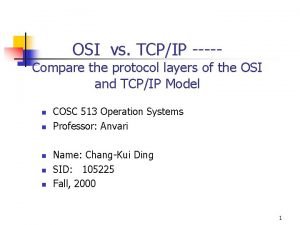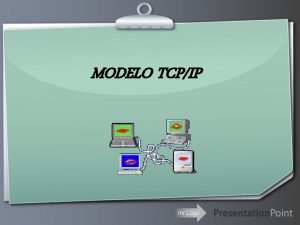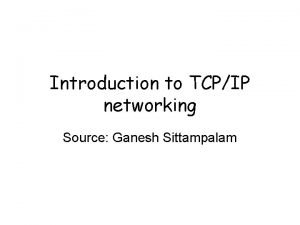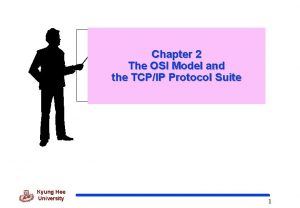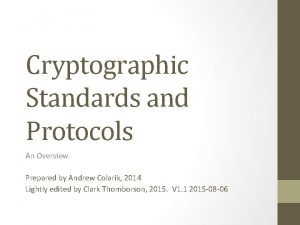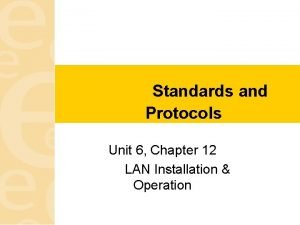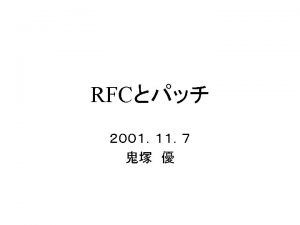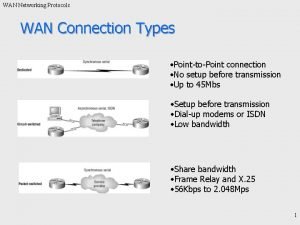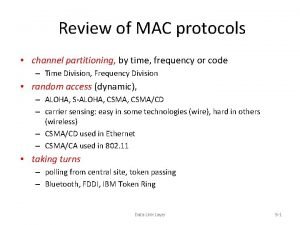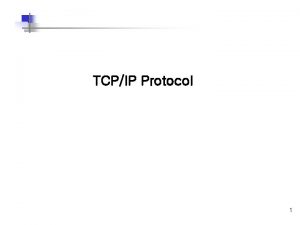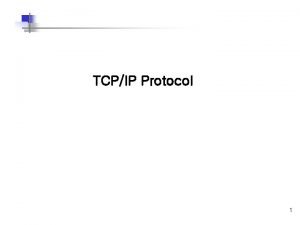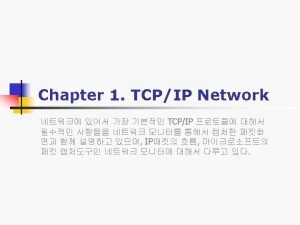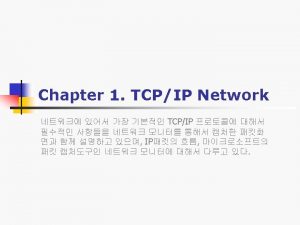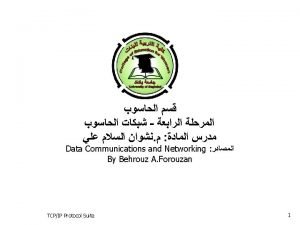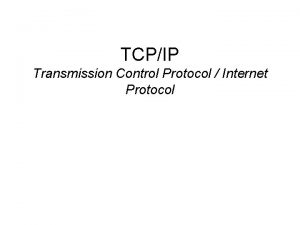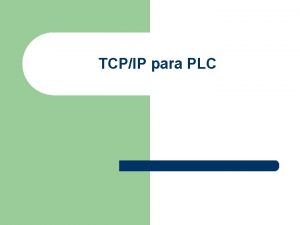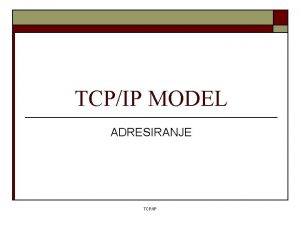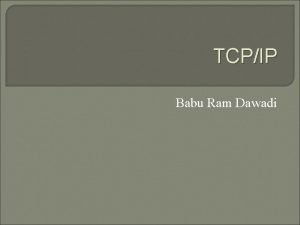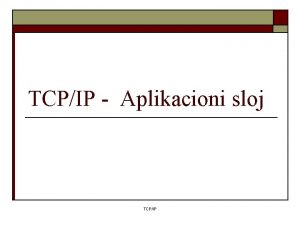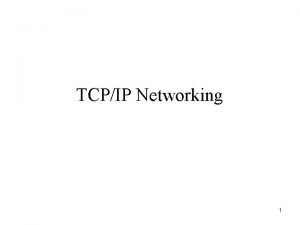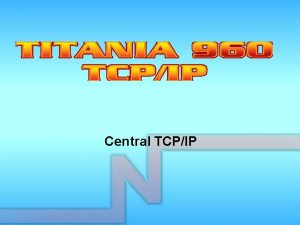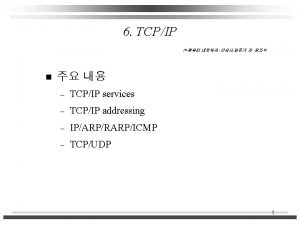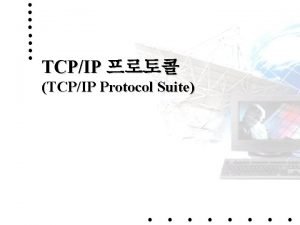CHAPTER 5 TCPIP PROTOCOLS PROTOCOL STANDARDS Protocols are

















- Slides: 17

CHAPTER 5 TCP/IP PROTOCOLS

PROTOCOL STANDARDS Protocols are formal rules of behavior When computers communicate, it is necessary to define a set of rules to govern their communications among different computers & devices created by different vendors.

INTRODUCTION TO TCP/IP First developed in 1960 s by US Department of Defence for ARPAnet project. Basic language / protocol used for Internet & also used in a private network (Intranet/extranet). Used for connecting hosts on the Internet Includes UDP, ARP, TCP & IP as sub protocols. UNIX/Windows operating system have TCP/IP built into it for the Internet, thus making it a de facto (standard)

TCP/IP FEATURES Most important feature: routable which means it can carry network layer addressing information that can be interpreted by router. Protocols that can span more than one LAN are called routable protocols. Other features: Open protocols standards & freely available Widely used for Internet, Intranet & Extranet Most products manufactured by vendors supports TCP/IP allows integration of different kind of networks. Has common addressing scheme that allows device to uniquely address on the entire network Standardized high level protocol for consistent, widely available user services.

TCP/IP PROTOCOLS ARCHITECTURE The four layer model architecture: APPLICATION PRESENTATION SESSION TRANSPORT NETWORK INTERNET DATA LINK NETWORK INTERFACE PHYSICAL OSI Model TCP/IP Model

APPLICATION LAYER Provides the same function as the 3 layers of OSI (Application, Presentation & Session). Sockets & ports are used to describe the path over which applications communicate. Most application level protocols inside TCP/IP are associated with one or more port number.

TRANSPORT LAYER Two main protocols used are User Datagram Protocol(UDP) & Transmission Control Protocol(TCP). TCP = connection oriented protocol which means it guarantees information transmission. UDP = connectionless protocol which transports datagram without end-to-end reliability checking. UDP is much faster as there is no time delay for checking & verifying data. So is is used for sound & video transmission.

TRANSPORT LAYER TCP UDP Connection oriented Reliable – delivery is guaranteed connectionless Unreliable – not guaranteed delivery Ordered – message arrived at the receiver is in order Heavyweight – when packets arrived in wrong order, request sent to sender to resend Not ordered – might be jumbled up Lightweight – no tracking of connection / order of the packet.

INTERNET LAYER Primary protocol is Internet Protocol (IP) All upper & lower layer communication must travel through IP layer in the TCP/IP stack. Responsible for assigning unique address, called IP address. Other supporting protocol: ICMP to facilitate the routing process.

NETWORK INTERFACE LAYER Data link layer & physical layer grouped together to become network interface layer. Makes use of existing data link & physical layer standards rather than defining its own.

INTERNET PROTOCOL (IP) Belong to network layer of OSI & TCP/IP model. Provides information about how & where data should be sent by including source & destination addresses. At network layer of OSI model, data is formed into packet & the packets are called IP datagram in the context of TCP/IP. IP datagram act as an envelope for data & contains the addresses for routing purposes.

INTERNET PROTOCOL (IP) Addressing – uses 32 bit addresses to identify the sending & receiving hosts. These addresses are used by routers to route the data. Fragmentation – IP packets may be split / fragmented into smaller packets. This permits a large packet to travel across a network which can only handle smaller packets. Packet timeouts – each IP packet contains Time To Live(TTL) field which is decremented every time a router handles the packet. If TTL reaches zero, the packet is discarded preventing the packets from running in circles forever & flooding network!

IP ADDRESSING FUNDAMENTALS Network recognizes 2 types of addresses : Logical (Network address) & Physical (MAC/Hardware address) MAC addresses = assigned to Network Interface Cards (NICs) by manufacturer at factory & cannot be changed easily. Logical Addresses = assigned manually & can be changed easily. Current version of IP which is IPv 4 is a unique 32 bit binary number assigned to every device that connects to IP based network. (also known as dotted decimal notation !) IP addresses are classified into 3 classes; A, B & C

IP ADDRESSING FUNDAMENTALS IPv 6 (Internet Protocol version 6) A new version of IP designed to be evolutionary step to IPv 4 Key to IPv 6 enhancement is the expansion of IP address space from 32 bits to 128 bits, enabling unlimited unique IP address Recommended by Internet Engineering Task Force(ITEF) on 25 th July 1994. Has auto configuration feature, automatically configures interface & router address for you. IPv 6 protocol can co-exist with current IPv 4 Ex: 3 ff 3: ffff: 101: : 230: 6 eff: fe 04: d 9 ff

TCP/IP APPLICATIONS SMTP Simple Mail Transfer Protocol (SMTP) is an application layer protocol in TCP/IP. It is a standard email protocol on the Internet as it defines the message format for the email & also the way server handles these messages. Most email system uses SMTP to send messages from one server to another. SMTP server route messages throughout the Internet to a mail server that provides a message store for incoming mail. Uses TCP port number 25. Ex : name@cosmopoint. com. my

TCP/IP APPLICATIONS FTP File Transfer Protocol is a standard protocol for exchanging files over the Internet. Uses Internet’s TCP/IP protocols to enable data transfer. Most commonly used to download a file from a server using the Internet / to upload a file to the server (uploading webpage to a server!)

TCP/IP APPLICATIONS TELNET A text based, terminal emulation program for TCP/IP networks such as Internet. telnet program enables you to connect your PC to a server at different location on the network. Used for executing commands through telnet program consul which is executed as if entered directly on the server console. Enable you to control the server & communicate with other servers on the Internet. In oder to connect to remote server, you have to provide the Host Name, Port Number(telnet port number 23) & terminal type.
 Antigentest åre
Antigentest åre Osi
Osi Tcpip
Tcpip Modelo tcpip
Modelo tcpip Iso/osi vs. tcp/ip
Iso/osi vs. tcp/ip Arquitetura
Arquitetura Que significa
Que significa Ganesh sittampalam
Ganesh sittampalam Ois 7계층
Ois 7계층 Cryptography standards and protocols
Cryptography standards and protocols Lan standards and protocols
Lan standards and protocols Protocols and standards in computer networks
Protocols and standards in computer networks Internet official protocol standards
Internet official protocol standards Factors necessary for appropriate service standards
Factors necessary for appropriate service standards Chapter 3 network protocols and communications
Chapter 3 network protocols and communications Network protocols map
Network protocols map Data link
Data link Channel partitioning mac protocols
Channel partitioning mac protocols




